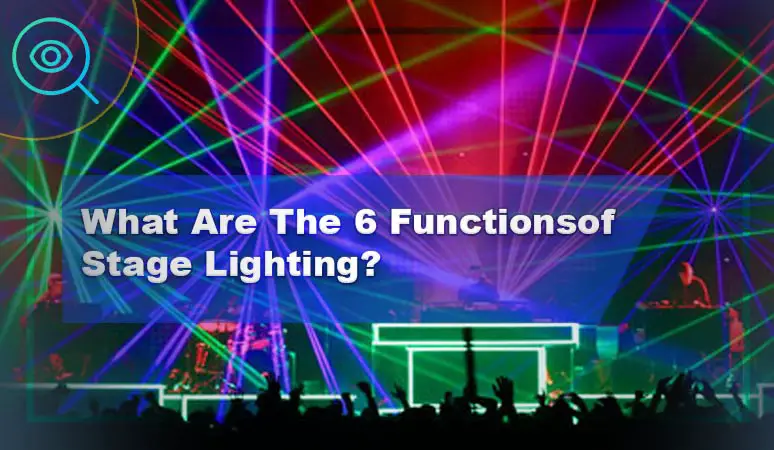Performance can be successful and effective when you pay attention to all the crucial factors related to it. And the stage lighting is one of those. If the illumination inside stage is not proper, audience won’t be able to have right feel of a certain act.
Clearly witnessing what’s taking place in the stage is very important to make audience engage with performance. And stage lighting is possibly the most critical thing to care about here. At very least, one definitely needs to ensure the main six factors that ensure good stage lighting. What are the 6 functions of stage lighting, let’s find it out…
What Are The 6 Functions of Stage Lighting & How It Results to a Successful Performance?
There are more than six when it comes to counting every little detail about the lighting on a particular stage. But the six functions that we’ll be talking about below are absolute must if you want to capture and direct attention.

1. The Visibility Function
A lighting designer needs to start this whole stage light planning from the visibility factor. If the stage actors are not visible comfortably, then there’s a good chance audience won’t be able to understand dialogues. Sounds odd but that’s true.
Lip reading is the matter behind. Even without us knowing, we actually do a lot of lip reading. And so, without proper visibility, the audience engagement will not be as expected as you’d like it to be.
The factor visibility is a bit complicated than what this term initially makes you think. The design needs to focus on selective visibility specifically. So that there’s a chance to control what the audience can see. Here the light and shadow contrast are definitely going to be applicable. It needs to be in a strategic way so that other lighting functions don’t get disrupted.
2. The Focus Function.
The next most important function of lighting for stage is focus. The lighting designed needs to use stage light for controlling audience focus to area or characters that need attention at a certain point in time.
This is quite similar to the function of a camera in plays or acts. Imagine a scene where a helicopter flies over the hill to expose orcs in position for an upcoming destroy. There’s a lot going on in this scene. But if the camera zooms in to the main lead who’ll storm through gate, audience will quickly give their attention to that actor.
Quite similar to stage lighting. The design needs to create a focus on characters by implementing a few tactics. In scenarios that need less individual attention, lighting stays even for the audience to focus on entire scene.
While in scenes that need to emphasis one important character or conversation, the light elements are adjusted to grab attention to those particular areas. Intensity, color contrast, blurring, and such elements are used for making the focus function work.
3. The Composition Factor.
This is more likely a subset of intensity and focus. Those who have studied set design might already know about how object arrangement on stage is greatly important. To make the intended stage picture come alive, it’s important to place actors in stage sensibly.
And that’s quite similar to the lighting as well. The intensity of lighting on an actor or particular stage areas will get a good influence from physical environment composition. To make a pleasant composition, it’s important to maintain a balance of the set design through lighting. To make certain areas more on focal point while not completely vanishing its surrounding, that’s what the lighting is supposed to do for composition.
4. The Picture Function
To let the audience, know when and where we are, lighting is one crucial element to work on. It’s going to help you show the location as well as timing. Also, it helps to display if a scene is outside or inside.
It’s also capable of telling the audience about weather and information of all circumstances that need to be delivered to them. Using a leafy breakup for a high angle shot while light source brightening treetops, this scenery sends message to the audience that it’s an outdoor space.
The light intensity can help to let the viewers know whether or not it’s deep in woods. A bright amber light will create a day set. While using pale blue lighting, the stage will look more like a night setup.
The storytelling part needs support from lighting whenever it’s necessary. And this realistic situation creating part may not always be necessary. But in some cases, you need to use it to make the storytelling more believable.
5. The Mood Function.
The emotional reality of a scene is very essential to make a play successful. And lighting can be a huge element to affect the mood and bring more concentration to scenes that demands it. Sometimes scenery and costumes are not enough to display the feel of a play.
However, lighting can help greatly here by creating the necessary mood. It needs to be in balance with what scene is taking place or the actor’s actions, not just environment. Through lighting theatre in a certain way, you can move audience to the emotion that needs to be there. Quite similar to what background music does.
6. The Form Revelation Function.
This one is quite similar to visibility, but with a slightly different angle. Visibility is all about making certain elements visible or invisible by using the lighting of stage. It’s related to the revelation and alteration that is needed for scenes differently.
But it’s also important to bring out the form of props and actors in a 3-D quality. Or else the scene will look a lot unrealistic because of various light effects. The stage lighting needs to use shadows of objects and people to create new forms and feels. It’s supposed to help in bringing forward what’s in the background or vice versa if necessary. And that’s what the whole form revelation function is all about.
Outdoor Speak: Have you wondered if using solar tube lights is just as sensible as using stage lights? We’ll help you shed light on this one — Solar Tube Lighting.
Watch This!
Wrap Up
So now you know what are the 6 functions of stage lighting and how significantly they help to make a play successful. No matter if it’s about stage plays or concerts, the lighting is definitely a vital role player. It’s responsible to give a performance the vibrance, captivation, and interestingness. And so, you need to be ensuring at least these six functions for a performance to become successful through your stage lighting designing skills.

